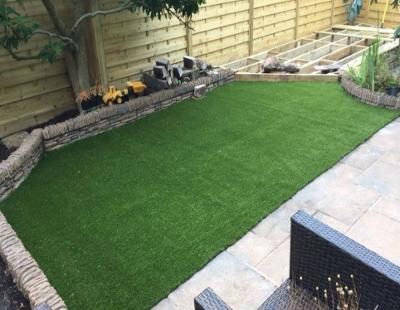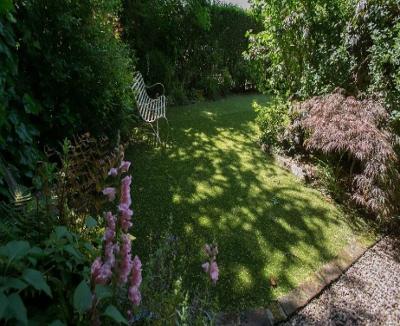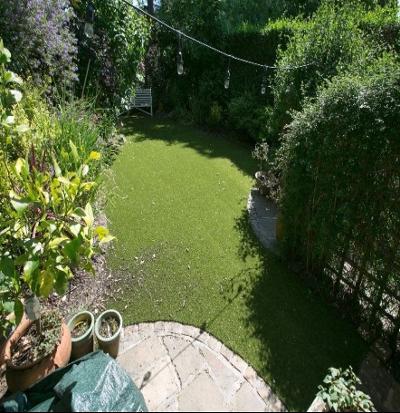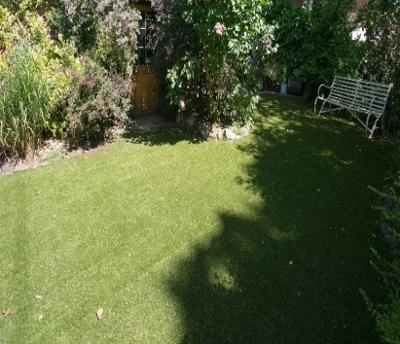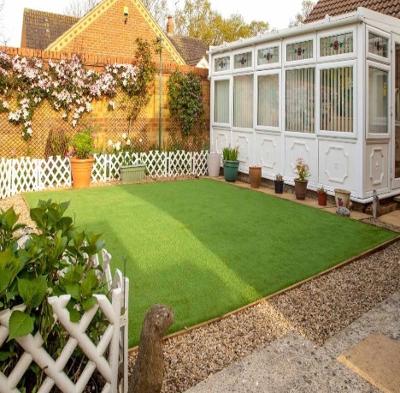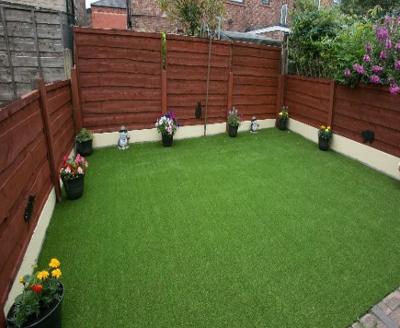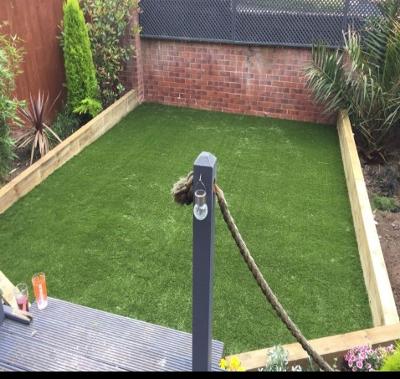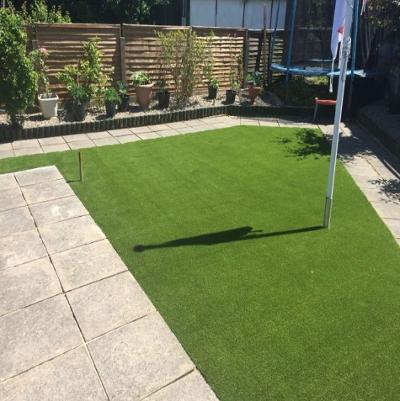Artificial Grass in Ayrshire
Suppliers and fitters of Artificial Grass AKA Astroturf in Irvine, North Ayrshire
Artificial Grass fitted in Ayrshire
- The Right Way - Full Landscaping Service
If you are looking to fake grass on a supply only basis, our grasses start from £6 per square metre to £35 per square metre
6mm thick to 50mm thick. Suppliers to Trade and for DIY.
Astrograss, astroturf, synthetic lawn, fake grass etc are all just names for artificial grass, AstroTurf being the brand name of the original, pioneering American manufacturer.
Here at Aable Artificial Grass we have over 150 types of fake turf ranging from 6mm to 50mm thick. The thickest fake lawn we do is the Mayfair by Easigrass and this is regarded as the most realistic grass in the UK with the unique feature, that the grass blades go in all sorts of different directions. The Mayfair is almost indistinguishable from real grass.
Prices start from the low cost, cheap ones at £6 per square metre up to around £35 per square metre for the really fancy, luxurious stuff (supply only).
The quality of artificial grass is not dictated by it's thickness , contrary to what most people think, there are various factors involved.
Pile Height
Thick pile height does not necessarily mean high quality.
Most of the enquiries that we get however, are normally requesting how much per square metre our 40 millimetre grass costs. To simplify things and make it easier for our customers we tend to carry just a small amount of 40mm astrograss. The better grasses tend to be a bit denser and with more natural looking colours.
Ideal Pile Height?
So you have decided to get some artificial grass from an Ayrshire artificial grass supplier or maybe even decided to get it fitted by and Ayrshire artificial grass installer, the question is now "what thickness of astrograss do I need?"
If you prefer the appearance of a newly mown lawn then an astroturf of between 22mm and 30mm is normally recommended. For a natural looking, slightly grown lawn, you would be better choosing an artificial grass with a pile height of between 30mm and 38mm, bearing in mind that there will be a backing of approximately 2mm under the grass blades. A 38mm pile height will often be referred to as a 40mm fake grass.
Please be aware that if you go for a longer pile, then the grass blade fibres are more likely to lie down flatter rather than remaining upright. Longer grass blades, however, can be support to some extent by brushing in around 5kg of kiln dried sand per square metre of grass. The sand will also give more weight to the fake lawn and thus help anchor it down and help it to resist movement and creases.
As a general rule of thumb (but not always) shorter pile grasses tend to be more hard wearing. If you are buying nylon astroturf, then there tends to be no difference in durability.
Pile Density
The density of the fake grass blades or fibres as they are sometimes know, is most definitely a factor to be considered when buying artificial grass. A higher pile density, i.e. more grass blades per square metre, will generally result in a more lush, thick and quality grass and generally of a much more natural and realistic appearance. We regularly compare artificial grasses from various importers, manufactures and grass trade suppliers to evaluate their quality and value for money.
On one particular occasion, we compared two 25mm thickness grasses from two different grass companies to find that although both had 25mm long grass blades, one was significantly thicker than the other. Why can that be? One grass was far more densely packed with grass blades while the other had on a thin, sparse area of blades/fibres which caused the grass blades to lie almost flat.
Yes, they are both sold as 25mm astrograss and technically both are but the difference in quality and looks was night and day.
Ultimately the thickness of a grass's' pile height has normally got
no relevance
whatsoever to it's quality.
Stitch Rate
What does this mean? Fake grass is stitched into it's backing, normally made from polyurethane or latex. The stitching will flow down the length of the artificial grass roll and the more frequent the stitching then the higher the stitch rate. The higher the stitch rate means better quality than that of a low stitch rate grass. Grasses with higher stitch rates will also mean that you are less likely to see the backing material through the grass blades.
Stitch Gauge
This can be described best by saying that when you are looking across the way at the grass backing and seeing how close the rows of stitches are to each other and how close or how wide the rows of stitches are separated i.e. how wide the gaps are between the stitching rows. Intense stitching gauge will again mean less chance of seeing the backing through the grass blades and it's also a contributor to better quality..
Weight per Square Metre
Does the heavier the weight per square metre mean better quality? Often yes, but not necessarily so. Obviously longer grass pile normally weighs more the shorter pile, more stitching intensity weighs more than sparse stitching, high quality yarns weigh more than low quality yarns, high density grass weighs more than low density grasses? This, as you can imagine, is normally the case, and is true in most cases but some of the backings are deliberately heavily weighed down with multiple layers of glue which do not contribute to a higher quality grass. If the grass backing is hard and very firm to touch and difficult to bend, then there is a strong possibility that there are numerous layers of glue which is done solely to increase the weight per square metre with no gain in quality.
The under-noted also needs to be considered
Quality of the stitching
Yarn quality
Backing material
Grass blade type
We supply
and fit our great value for money artificial grass for our customers in Ayrshire and around Glasgow.
Our prices are the best around, certainly far less than any artificial grass shops or carpet warehouse can offer. This is because we buy in bulk and we don't have many overheads to pay as we don't operate out of a showroom.
Service Areas
North Ayrshire - Irvine, Dreghorn. Kilwinning, Stevenston, Saltcoats, Ardrossan, west Kilbride, Seamill, Largs, Skelmorlie, Dalry, Beith, Kilbirnie, Glengarnock
South Ayrshire - Troon, Barassie, Prestwick, Maybole, Girvan
East Ayrshire - Kilmarnock, Hurlford, Crookedholm, Mauchline, Auchenleck, Cumnock, New Cumnock, Muirkirk
Glasgow
East Kilbride
Artificial Grass Trade Suppliers and Wholesale Importers
The demand for good looking artificial grass has never been better
AstroTurf is where it all began
AstroTurf was the original brand and pioneer of artificial grass back in the day.
Ayrshire Artificial Grass Installers Guide
This is a quick guide to fake grass fitting/installation, assuming that the grass is to be fitted over existing natural grass or over an unprepared soil area.
NB
Fitting artificial grass on concrete or decking is a totally different method of installing.
Before carrying out the ground excavation/preparation, it is recommended that the new artificial grass to be laid is rolled out flat and left to settle for a period of 24 hours.
- Excavate the area to a depth of 100mm
- Compact the area with a compactor plate
- Treat the area with the correct weedkiller
- Fix 4 x 2 tanalised timber batons around the perimeter of the area to be fitted with fake lawn. These should be secured by tanalised wooden stakes. The stakes should be driven into the ground and screwed (galvanised or stainless steel screws) into the timber batons after they have been levelled throughout
- Lay a weed membrane, held in place against the timber batons by some galvanised screws and a 150mm wide layer of postcrete (this will secure the membrane to batons and stop weeds coming through the edges
- Mark a line on the timber all the way round the timber batons, indicating a height of 75mm from the ground
- Fill the area with Type 1 MOT, spread evenly and compact using a compactor plate (usually done in 2 thinner layers). The compacted Type 1 should now be level with the 75mm line
- Now fill the area with whin dust (we prefer not to use sharp sand). Spread the whin dust evenly and compact until it is level with the top of the timber batons
- Lay a second layer of weed membrane
- Roll out the fake lawn that's to be fitted and overlap the timber batons by around 100mm. Ensure that the grass is straight, tight and unwrinkled, with the pile facing away from the house. The grass should now be carefully attached to the batons with galvanised screws or nails.
- Trim the area neatly around the edges with a box knife or carpet cutter
- Secure throughout the entire area with galvanised artificial grass pins or 6 inch galvanised nails
- Spread kiln dried sand at a rate of around 5kg per square metre and brush it in thoroughly to the extent of which that no sand can be seen. The purpose of the sand is to support the grass blades and keep them more erect and also to add weight to the artificial lawn to help avoid movement and wrinkling

